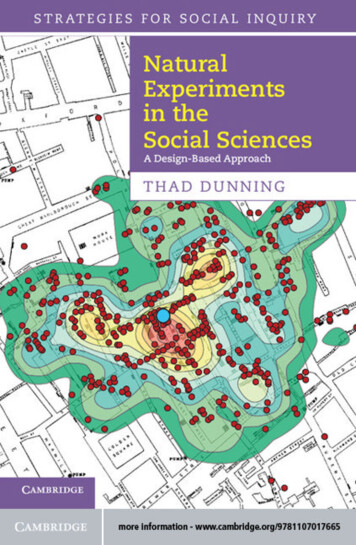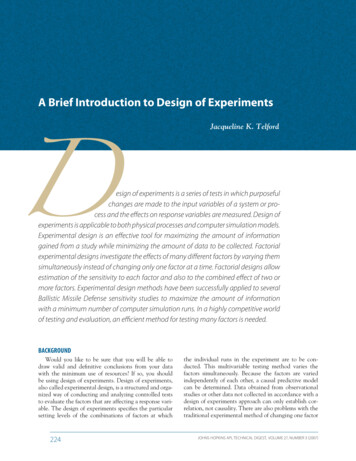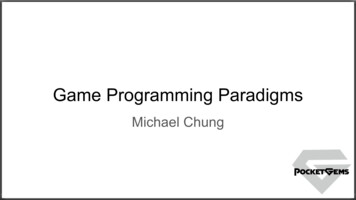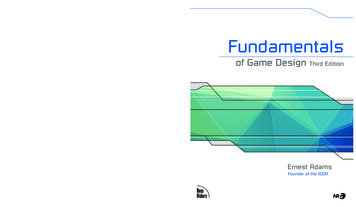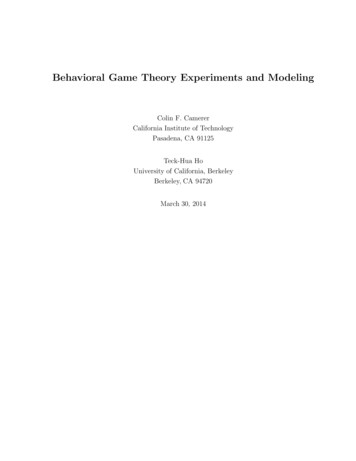
Transcription
Behavioral Game Theory Experiments and ModelingColin F. CamererCalifornia Institute of TechnologyPasadena, CA 91125Teck-Hua HoUniversity of California, BerkeleyBerkeley, CA 94720March 30, 2014
11IntroductionFor explaining individual decisions, rationality – in the sense of accurate belief and optimization – may still be an adequate approximation even if a modest percentage ofplayers violate the theory. But game theory is different. Players’ fates are intertwined.The presence of players who do not have accurate belief or optimize can dramaticallychange what rational players should do. As a result, what a population of players is likelyto do when some do not have accurate belief or optimize can only be predicted by ananalysis which explicitly accounts for bounded rationality as well, preferably in a preciseway. This chapter is about what has been learned about boundedly rational strategicbehavior from hundreds of experimental studies (and some field data).In the experiments, equilibrium game theory is almost always the benchmark modelbeing tested. However, the frontier has moved well beyond simply comparing actual behaviors and equilibrium predictions, because that comparison has inspired several typesof behavioral models. Therefore, the chapter is organized around precise behavioral models of boundedly rational choice, learning and strategic teaching, and social preferences.We focus selectively on several example games which are of economic interest and explainhow these models work.We focus on five types of models1. Cognitive hierarchy (CH) model which captures players’ beliefs about steps of thinking, using one parameter to describe the average step of strategic thinking (level-k(LK) models are closely related). These models are designed to predict one-shotgames or initial conditions in a repeated game.2. A noisy optimization model called quantal response equilibrium (QRE). UnderQRE, players are allowed to make small mistakes but they always have accuratebeliefs about what other players will do.3. A learning model (called Experience-Weighted Attraction Learning (EWA)) to compute the path of equilibration. The EWA learning algorithm generalizes both fictitious play and reinforcement models. EWA can predict the time path of play as afunction of the initial conditions (perhaps supplied by CH model).4. An extension of the learning models to include sophistication (understanding howothers learn) as well as strategic teaching, and nonequilibrium reputation-building.
2This class of models allows the population to have sophisticated players who activelyinfluence adaptive players’ learning paths to benefit themselves.5. Models of how social preferences map monetary payoffs (controlled in an experiment) into utilities and behavior.Our approach is guided by three stylistic principles: Precision; generality; and empiricalaccuracy. The first two are standard desiderata in equilibrium game theory; the third isa cornerstone in empirical economics.Precision: Because game theory predictions are sharp, it is not hard to spot likelydeviations and counterexamples. Until recently, most of the experimental literature consisted of documenting deviations (or successes) and presenting a simple model, usuallyspecialized to the game at hand. The hard part is to distill the deviations into an alternative theory that is similarly precise as standard theory and can be widely applied.We favor specifications that use one or two free parameters to express crucial elementsof behavioral flexibility. This approach often embeds standard equilibrium as a parametric special case of general theory. It also allows sensible measures of individual andgroup differences, through parameter variation. We also prefer to let data, rather thanintuition, specify parameter values.Generality: Much of the power of equilibrium analyses, and their widespread use,comes from the fact that the same principles can be applied to many different games.Using the universal language of mathematics enables knowledge to cumulate worldwide.Behavioral models of games are also meant to be general, too, in the sense that the samemodels can be applied to many games with minimal customization. Keep in mind thatthis desire for universal application is not held in all social sciences. For example, manyresearchers in psychology believe that behavior is so context-specific that it is might betoo challenging to create a common theory that applies to all contexts. Our view is thatwe can’t know whether general theories are hopeless until we try to apply them broadly.Empirical discipline: Our approach is heavily disciplined by data. Because gametheory is about people (and groups of people) thinking about what other people andgroups will do, it is unlikely that pure logic alone will tell us what will happen. As theNobel Prize-winning physicist Murray Gell-Mann said, “Imagine how difficult physicswould be if electrons could think” It is even harder if we don’t watch what ‘electrons’ dowhen interacting.
3Our insistence on empirical discipline is shared by others. Eric Van Damme (1999)thought the same:Without having a broad set of facts on which to theorize, there is a certaindanger of spending too much time on models that are mathematically elegant,yet have little connection to actual behavior. At present our empirical knowledge is inadequate and it is an interesting question why game theorists havenot turned more frequently to psychologists for information about the learningand information processes used by humans.Experiments play a privileged role in testing game theory. Game-theoretic predictionsare notoriously sensitive to what players know, when they move, and how they valueoutcomes. Laboratory environments provide crucial control of all these variables (seeCrawford, 1997; Camerer, 2003). As in other lab sciences, the idea is to use lab control tosort out which theories work well and which don’t, then later use them to help understandpatterns in naturally-occurring data. In this respect, behavioral game theory resemblesdata-driven fields like labor economics or finance more than equilibrium game theory.Many behavioral game theory models also circumvent two long-standing problemsin equilibrium game theory: Refinement and selection. These models “automatically”refine sets of Bayesian-Nash equilibria because they allow all events to occur with positiveprobability, and hence Bayes’ rule can be used in all information sets. Some models(e.g. CH and LK) also automatically avoid multiplicity of equilibria by making a singlestatistical prediction. Surprisingly, assuming less rationality on players therefore canlead to more precision (as noted previously by Lucas, 1986).2Cognitive Hierarchy and Level-k ModelsCognitive Hierarchy (CH) and level-k (LK) models are designed to predict behavior inone-shot games and to provide initial conditions for models of learning.We begin with notation. Strategies have numerical attractions that determine theprobabilities of choosing different strategies through a logistic response function. Forplayer i, there are mi strategies (indexed by j) which have initial attractions denoted
4Aji (0). Denote i’s jth strategy by sji , chosen strategies by i and other players (denoted i) in period t as si (t) and s i (t), and player i’s payoffs of choosing sji by πi (sji , s i (t)).A logit response rule is used to map attractions into probabilities:jPij (teλ·Ai (t) 1) mij 1j eλ·Ai(t)(2.1)where λ is the response sensitivity.1 Since CH and LK models are designed to predictstrategic behaviors in only one-shot games, we focus mainly on Pij (1) (i.e. no learning).We shall use the same framework for learning models too and the model predictions therewill go beyond one period.We model thinking by characterizing the number of steps of iterated thinking thatsubjects do, their beliefs, and their decision rules.2 Players using zero steps of thinking,do not reason strategically at all. We think these players are using simple low-effortheuristics, such as choosing salient strategies (cf. Shah and Oppenheimer, 2008). Ingames which are physically displayed (e.g. battlefields) salience might be based on visualperception (e.g. Itti and Koch, 2000). In games with private information, a strategychoice that matches an information state might be salient– e.g. bidding one’s valueor signal in an auction). Randomizing among all strategies is also a reasonable step-0heuristic when no strategy is particularly salient.Players who do one step of thinking believe they are playing against step 0 types.Proceeding inductively, players who use k steps think all others use from zero to k 1steps. Since they do not imagine same- and higher-step types there is missing probability;we assume beliefs are normalized to adjust for this missing probability. Denote beliefsof level-k players about the proportion of step h players by gk (h). In CH, gk (h) f(h)/ k 1k 0 f(k ) for h k 1 and gk (h) 0 for h k. In LK, gk (k 1) 1. The LKmodel is easier to work with analytically for complex games.It is useful to ask why the number of steps of thinking might be limited. One possibleanswer comes from psychology. Steps of thinking strain “working memory”, becausehigher step players need to keep in mind more and more about what they believe lower1Note the timing convention– attractions are defined before a period of play; so the initial attractionsdetermine choices in period 1, and so forth.This concept was first studied by Stahl and Wilson (1995) and Nagel (1995), and later by Ho,Camerer and Weigelt (1998).Aji (0)2
5steps will do as they form beliefs. Evidence that cognitive ability is correlated with morethinking steps is consistent with this explanation (Devetag and Warglien, 2008; Camerer,Chong and Ho, 2004; Gill and Prowse, 2012).However, it is important to note that making a step k choice does not logically implya limit on level of thinking. In CH, players are essentially defined by their beliefs aboutothers, not by their own cognitive capabilities. For example, a step 2 player believesothers use 0 or 1 steps. It is possible that such players are capable of even higher-stepreasoning (e.g. choosing Nash equilibria) if they thought their opponents were of highersteps. CH and level-k models are not meant to permit separation of beliefs and “reasoningskill”, per se (though see Kneeland, 2013 for evidence).An appealing intuition for why strategic thinking is limited is that players endogeneously choose whether to think harder. The logical challenge in such an approach isthis: A player who fully contemplated the benefit from doing one more thinking stepwould have to derive the optimal strategy after the additional thinking. Alaoui andPenta (2013) derive an elegant axiomatization of such a process by assuming that playerscompute the benefit from an extra step of thinking based on its maximum payoff. Theyalso calibrate their approach to data of Goeree and Holt (2001) with some success.Of course, it is also possible to allow players to change their step k choice. Indeed, Hoand Su (2013) and Ho et al. (2013) make CH and level-k models dynamic by allowingplayers to update their beliefs of other players’ steps of thinking in sequential games. Intheir dynamic level-k model, players not only choose rules based on their initial guesses ofothers’ steps (like CH and level-k) but also use historical plays to improve their guesses.Their dynamic level-k model captures two systematic violations of backward inductionin centipede games, limited induction (i.e., people violate backward induction more insequential games with longer decision trees) and repetition unraveling (i.e. choices unravel towards backward induction outcomes over time) and explains learning in p-beautycontests and sequential bargaining games.The key challenge in thinking steps models is pinning down the frequencies of playersusing different numbers of thinking steps. A popular nonparametric approach is to letf(k) be free parameters for a limited number of steps k; often the three steps 0, 1, and 2will fit adequately. Instead, we assume those frequencies have a Poisson distribution with τ kmean and standard deviation τ (the frequency of step k types is f(k) e k!τ ). Then τis an index of aggregate bounded rationality.
6The Poisson distribution has only one free parameter (τ ); it generates “spikes” inpredicted distributions reflecting individual heterogeneity (some other approaches do notreflect heterogeneity3); and for typical τ values the Poisson frequency of step types isroughly similar to estimates of nonparametric frequencies (see Stahl and Wilson (1995);Ho, Camerer and Weigelt (1998); and Nagel et al., 1999).Given this assumption, players using k 0 steps are assumed to compute expectedpayoffs given their adjusted beliefs, and use those attractions to determine choice probabilities according toAji (0 k)m i h 1πi (sji , sh i )·{k 1 f(c)h· P i[ k 1(1 k )]}f(c) c 0k 0(2.2)where Aji (0 k) and Pil (1 k )) are the attraction of step k in period 0 and the predictedchoice probability of lower step k in period 1. Hence, the predicted probability of levelK in period 1 is given by:jPij (1 K)eλ·Ai (0 K) mij 1j eλ·Ai(0 K).(2.3)Next we apply CH to three types of games: dominance-solvable p-beauty contests,market entry, and LUPI lottery choices. Note that CH and LK have also been appliedto literally hundreds of other games of many structures (including private information)(see Crawford, et al., 2013).2.1P-beauty contestIn a famous passage, Keynes (1936) likens the stock market to a newspaper contest inwhich people guess which faces others will judge to be the most beautiful. He writes:It is not the case of choosing those which, to the best of one’s judgment, arereally the prettiest, nor even those which average opinion genuinely thinks the3Alternatives include the theory of noisy expectation by Capra (1999) and the closely related theoryof “noisy introspection” by Goeree and Holt (1999b). Both models do not accommodate heterogeneity.
7prettiest. We have reached the third degree, where we devote our intelligencesto anticipating what average opinion expects the average opinion to be. Andthere are some, I believe, who practice the fourth, fifth, and higher degrees [p.156].The essence of Keynes’s observation is captured in a game in which players are askedto pick numbers from 0 to 100, and the player whose number is closest to p times theaverage number wins a prize. Suppose p 2/3 (a value used in many experiments).Equilibrium theory predicts each contestant will reason as follows: “Even if all the otherplayers guess 100, I should guess no more than 2/3 times 100, or 67. Assuming that theother contestants reason similarly, however, I should guess no more than 45 . . .” andso on, finally concluding that the only rational and consistent choice for all the playersis zero. When the beauty contest game is played in experimental settings, the groupaverage is typically between 20 and 35. Apparently, some players are not able to reasontheir way to the equilibrium value, or they assume that others are unlikely to do so. Ifthe game is played multiple times with the same group, the average moves close to 0.Table 1 shows data from 24 p-beauty contest games, with various p and conditions.Estimates of τ for each game were chosen to minimize the (absolute) difference betweenthe predicted and actual mean of chosen numbers. The table is ordered from top tobottom by the mean number chosen. The first seven lines show games in which theequilibrium is not zero; in all the others the equilibrium is zero.4The first four columns describe the game or subject pool, the source, group size,and total sample size. The fifth and sixth columns show the Nash equilibrium and thedifference between the equilibrium and the average choice. The middle three columnsshow the mean, standard deviation, and the mode in the data. The mean choices aregenerally far off from the equibrium; they choose numbers that are too low when theequilibrium is high (first six rows) and the numbers that are too high when the equibriumis low (lower rows). The rightmost six columns show the estimate of τ from the PoissonCH model, and the mean, prediction error, standard deviation, and mode predicted bythe best-fitting estimate of τ , and the 90 percent confidence interval of τ estimated froma randomized resampling (bootstap) procedure.[Insert Table 1 here]4In games in which the equilibrium is not zero, players are asked to choose a number that is closestto p times the average number a nonzero constant.
8There are several interesting patterns in Table 1. The prediction errors of the mean(column 13, “error”) are extremely small, less than .6 in all but two cases. This is nosurprise since τ is estimated (separately in each row) to minimize this prediction error.The pleasant surprise is that the predicted standard deviations and the modal numberchoices which result from the error-minimizing estimate of τ are also fairly close (acrossrows, the correlation of the predicted and actual standard deviation is .72) even thoughτ ’s were not chosen to match these moments. The values of τ have a median and meanacross rows of 1.30 and 1.61. The confidence intervals have a range of about one insamples of reasonable size (50 subjects or more).Note that nothing in the Poisson-CH model, per se, requires τ to be fixed across gamesor subject pools, or across details of how games are presented or choices are elicited.Outlying low and high values of τ are instructive about how widely τ might vary, andwhy. Estimates of τ are quite low (0 .1) for the p-beauty contest game when p 1 and,consequently, the equilibrium is at the upper end of the range of possible choices (rows1-2). In these games, subjects seem to have trouble realizing that they should choosevery large numbers when p 1 (though they equilibriate rapidly by learning; see Ho,Camerer, and Weigelt [1998]). Low τ ’s are also estimated among the PCC (PasadenaCity College) subjects playing two- and three-player games (row 8 and 10). High valuesof τ ( 3-5) appear in games where the equilibrium in the interior, 72 (row 7-10) small incremental steps toward the equilibrium in these games produce high values of τ .High τ values are also estimated in games with an equilibrium of zero when subjects areprofessional stock market portfolio managers (row19), Caltech students (row 20), gametheorists (row 24), and subjects self-selecting to enter newspaper contests (row 25). Thelatter subject pools show that in high analytical and educated subject pools (especiallywith self-selection) τ can be much higher than in other subject pools.A sensible intuition is that when stakes are higher, subjects will use more steps ofreasoning (and may think others will think harder too). Rows 3 and 6 compare low stakes( 1 per person per period) and high stakes ( 4) in games with an interior equilibriumof 72. When stakes are higher, τ is estimated to be twice as large (5.01 versus 2.51),which is a clue that some sort of cost-benefit analysis may underlie steps of reasoning(cf. Alaoui and Penta 2013).Notwithstanding these interesting outliers, there is also substantial regularity acrossvery diverse subject pools and payoff steps. About half the samples have confidenceintervals that include τ 1.5. Subsamples of corporate CEOs, high-functioning 80-year
9old spouses of memory-impaired patients, and high school students (rows 13, 15-16) allhave τ values from 1.1-1.7.An interesting question about CH modelling is how persistent a player’s thinking stepis across games. The few studies that have looked carefully found fairly stable estimatedsteps within a subject across games of similar structure (Stahl and Wilson, 1995; CostaGomes et al., 2001). For example, Chong, Camerer and Ho (2004) estimated separate τvalues for each of 22 one-shot games with mixed-equilibria. An assignment procedure thenchose a most-likely step for each subject and each game (given the 22 τ estimates). Foreach subject, an average of their first 11 estimated steps and last 11 estimated steps werecomputed. The correlation coefficient of these two average steps was .61. This kind ofwithin-subject stability is a little lower than many psychometric traits (e.g. intelligence,extraversion) and is comparable to econographic traits such as risk-aversion.Two studies looked most carefully at within-subject step stability. Georgiadis, Healyand Weber (2013) had subjects play variants of two structurally-different games. Theyfind modest stability of step choices within each game type, and low stability across thetwo game types. Hyndman et al. (2013) did the most thorough study; they measuredboth choices and beliefs across several baseline payoff-isomorphic games. They find that30% of subjects appear to maintain a stable type belief (mostly step 1) across games, andothers fluctuate between lower and higher belief between games. These studies bracketwhat we should expect to see about stability of step types– i.e. a mixture of stability.Since nothing in these theories commits to how stable “types” are, this empirical resultis not surprising at all.Finally, whether subjects maintain a single step type across games is neither predictedby the theory nor important for most applications. The most basic applications involveaggregate prediction, and sensitivity of predicted results to comparative static changesin game structure. It is very rare that the scientific goal is to predict what a specificsubject will do in one game type, based on their behavior in a different game type.2.2Market entry gamesConsider binary entry games in which there is a market with demand c (expressed as apercentage of the total number of potential entrants). Each of the many potential entrantsdecides simultaneously whether or not to enter the market. If a potential entrant thinks
10that fewer than c% will enter she will enter; if she thinks more than c% will enter shestays out.There are three regularities in many experiments based on entry games like this one(see Ochs, 1999; Seale and Rapoport, 2000; Camerer, 2003, chapter 7): (1) Entry ratesacross different levels of demand c are closely correlated with entry rates predicted by(asymmetric) pure equilibria or symmetric mixed equilibria; (2) players slightly overenter at low levels of demand and under-enter at high levels of demand; and (3) manyplayers use noisy cutoff rules in which they stay out for levels of demand below somecutoff c and enter for higher levels of demand.In Camerer, Ho, and Chong (2004), we apply the thinking model with best response(i.e., λ ) to explain subject behaviors in this game. Step zero players randomizeand enter half the time. This means that when c .5 one step thinkers stay out andwhen c .5 they enter. Players doing two steps of thinking believe the fraction of zerosteppers is f(0)/(f(0) f(1)) 1/(1 τ ). Therefore, they enter only if c .5 and.5, or when c .5 and c 1 τ. To make this more concrete, suppose τ 2.c .5 τ1 τThen two-step thinkers enter when c 5/6 and 1/6 c 0.5. What happens is thatmore steps of thinking “iron out” steps in the function relating c to overall entry. In theexample, one-step players are afraid to enter when c 1/2. But when c is not too low(between 1/6 and .5) the two-step thinkers perceive room for entry because they believethe relative proportion of zero-steppers is 1/3 and those players enter half the time.Two-step thinkers stay out for capacities between .5 and 5/6, but they enter for c 5/6because they know half of the (1/3) zero-step types will randomly stay out, leaving roomeven though one-step thinkers always enter. Higher steps of thinking smooth out stepsin the entry function even further.The surprising experimental fact is that players can coordinate entry reasonably well,even in the first period. (“To a psychologist,” Kahneman (1988) wrote, “this looks likemagic”.) The thinking steps model provides a possible explanation for this magic andcan account for the second and third regularities discussed above for reasonable τ values.Figure 1 plots entry rates from the first block of two studies for a game similar to the oneabove (Sundali et al., 1995; Seale and Rapoport, 2000). Note that the number of actualentries rises almost monotonically with c, and entry is above capacity at low c and belowcapacity at high c.Figure 1 also shows the thinking steps entry function N(all τ )(c) for τ 1.25.
11The function reproduces monotonicity and the over- and under- capacity effects. Thethinking-steps models also produce approximate cutoff rule behavior for all higher thinking steps except two. When τ 1.25, step 0 types randomize, step 1 types enter for allc above .5, step 2-4 types use cutoff rules with one “exception”, and steps 5-above usestrict cutoff rules. This mixture of random, cutoff and near-cutoff rules is roughly whatis observed in the data when individual patterns of entry across c are measured (e.g.,Seale and Rapoport, 2000).[Insert Figure 1 here ]This example makes a crucial point about the goal and results from CH modelling.The goal is not (just) to explain nonequilibrium behavior. Another goal is to explain alack of nonequilibrium behavior– i.e. when is equilibration remarkably good, even withno special training or experience, and no opportunities for learning or communication?Note that in p-beauty contest games, if some players are out of equilibrium then evensophisticated players will prefer to be out of equilibrium. However, in entry games ifsome players over- or under-react to the capacity c then the sophisticated players willbehave oppositely, leading to aggregate near-equilibrium. More generally, in games withstrategic complementarity a little irrationality (e.g. step 0) will be multiplied; in gameswith strategic substitutes a little irrationality will be mitigated (Camerer and Fehr, 2006).2.3LUPI lotteryA unique field study used a simple lottery played in Sweden by an average of 53783players per day, over seven weeks (Ostling et al., 2010). Participants in this lottery paid1 euro to pick an integer from 1 to 99,999. The participant who chose the lowest uniquepositive integer won a prize of 10,000 euros (hence, the lottery is called LUPI). Interestingly, solving for the Nash equilibrium for a fixed number of n players is computationallyintractable for large n. However, if the number of players is random and Poisson distributed across days, then the methods of Poisson games (Myerson, 1998) can be applied.The symmetric Poisson-Nash equilibrium (PNE) has an elegant simple structure wheren is the mean number of players and pk is the probability of playing integer k. Thesymmetric PNE has a striking nonlinear shape: Numbers from 1 to around 5500 arechosen almost equally often, but with slightly declining probability (i.e., 1 is most likely,2 is slightly less likely, etc.) (see Figure 2). A bold property of the PNE is that numbersabove 5513– a range that includes 95% of all available numbers– should rarely be chosen.
12[Insert Figure 2 here ]Figure 3 shows the full distribution of number choices in the first week, along withthe Poisson-Nash equilibrium and a best-fitting quantal CH model (i.e., λ is finite).Compared to the PNE, players chose too many low numbers, below 2000, and too manyhigh numbers. As a result, not enough numbers between 2000-5000 are chosen. CH canfit these deviations from PNE with a value of τ 1.80, which is close to estimates frommany experimental games. Intuitively, step 1 players choose low numbers because theythink step 0 randomizers will pick too many high numbers, step 2 numbers choose abovethe step 1 choices, and so on.[Insert Figure 3 here ]Despite that CH can explain the deviations of the number choices in LUPI lottery,the actual behavior is not far from the PNE prediction in general, given how preciselybold the predicted distribution is. Recall that PNE predicts only numbers below 5513will be played– excluding about 95% of the strategies– and overall, 93.3% of the numbersare indeed below that threshold. Furthermore, over seven weeks almost every statisticalfeature of the empirical distribution of numbers moved toward the PNE. For example,PNE predicts the average number will be 2595. The actual averages were 4512 in the firstweek and 2484 in the last week (within 4% of the prediction). A scaled-down laboratoryversion of LUPI also replicated these basic patterns.2.4SummarySimple models of thinking steps attempt to predict choices in one-shot games and provideinitial conditions for learning models. CH and level-k approaches incorporate discretesteps of iterated thinking. In Poisson-CH, the frequencies of players using different numbers of steps is Poisson-distributed with mean τ . While these models have been appliedto hundreds of experimental data sets, and several field settings, in this chapter we focussed on data from dominance-solvable p-beauty contests, market entry, a LUPI fieldlottery, and a private-information auction (See Section 3). For Poisson-CH, estimates ofτ are typically around 1-2. Importantly, CH can typically explain large deviations fromequilibrium and surprising cases in which equilibration occurs without communicationor experience (in entry games).
133Quantal response equilibriumThe CH and LK models explain nonequilibrium behavior by mistakes in beliefs aboutwhat other subjects will do, due to bounded rationality in strategic thinking. A differentapproach is to assume that beliefs are accurate, but responses are noisy. This approachis called quantal response equilibrium (QRE) (McKelvey and Palfrey, 1995). QRE relaxes the assumption that players always choose the best actions given their beliefs byincorporating “noisy” or ”stochastic” response. The theory builds in a sensible principlethat actions with higher expected payoffs are chosen more often; that is, players “betterrespond” rather than “best-respond”. If the res
answer comes from psychology. Steps of thinking strain “working memory”, because higher step players need to keep in mind more and more about what they believe lower 1Note the timing convention– attractions are defined before a period of play; so the initial attracti
